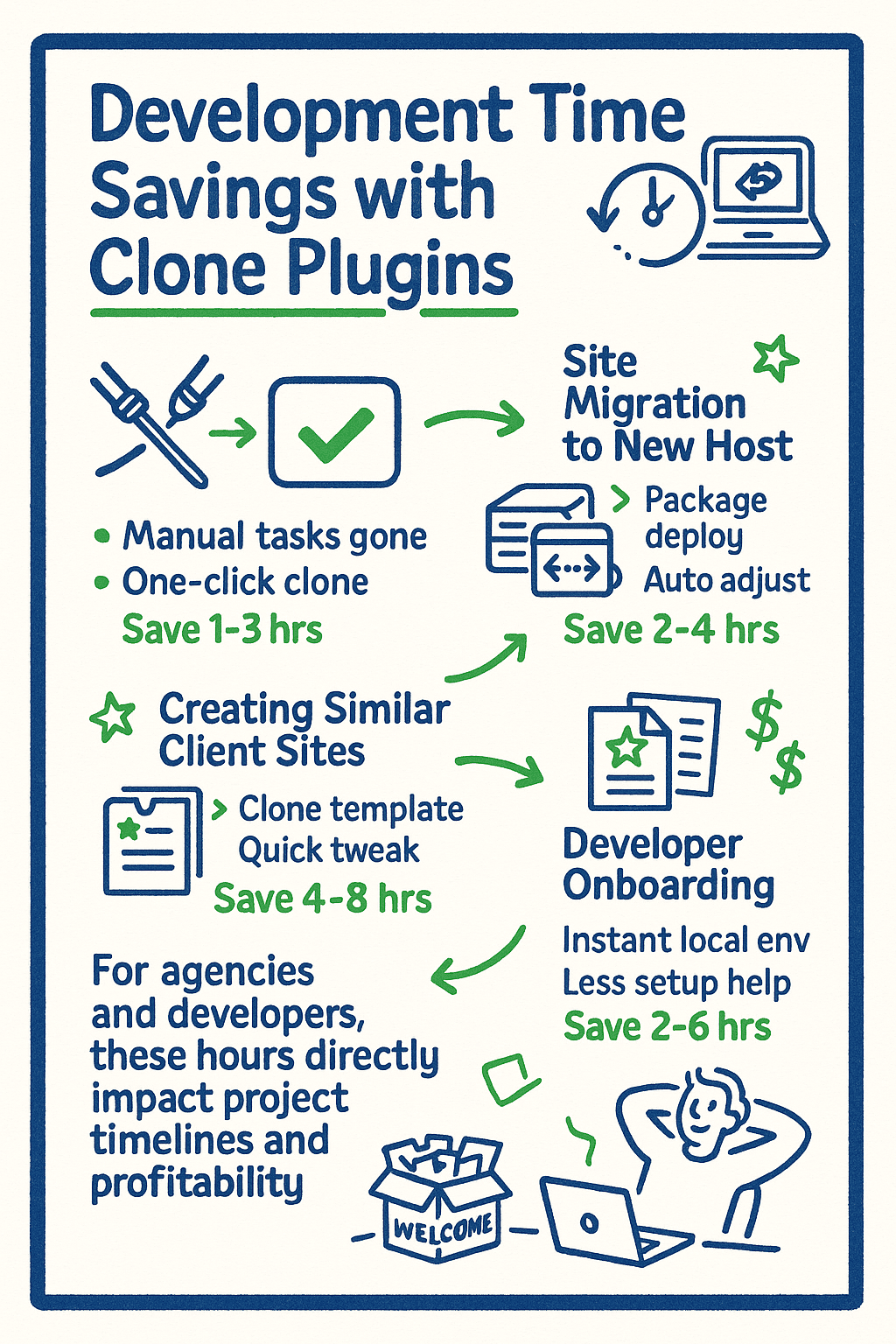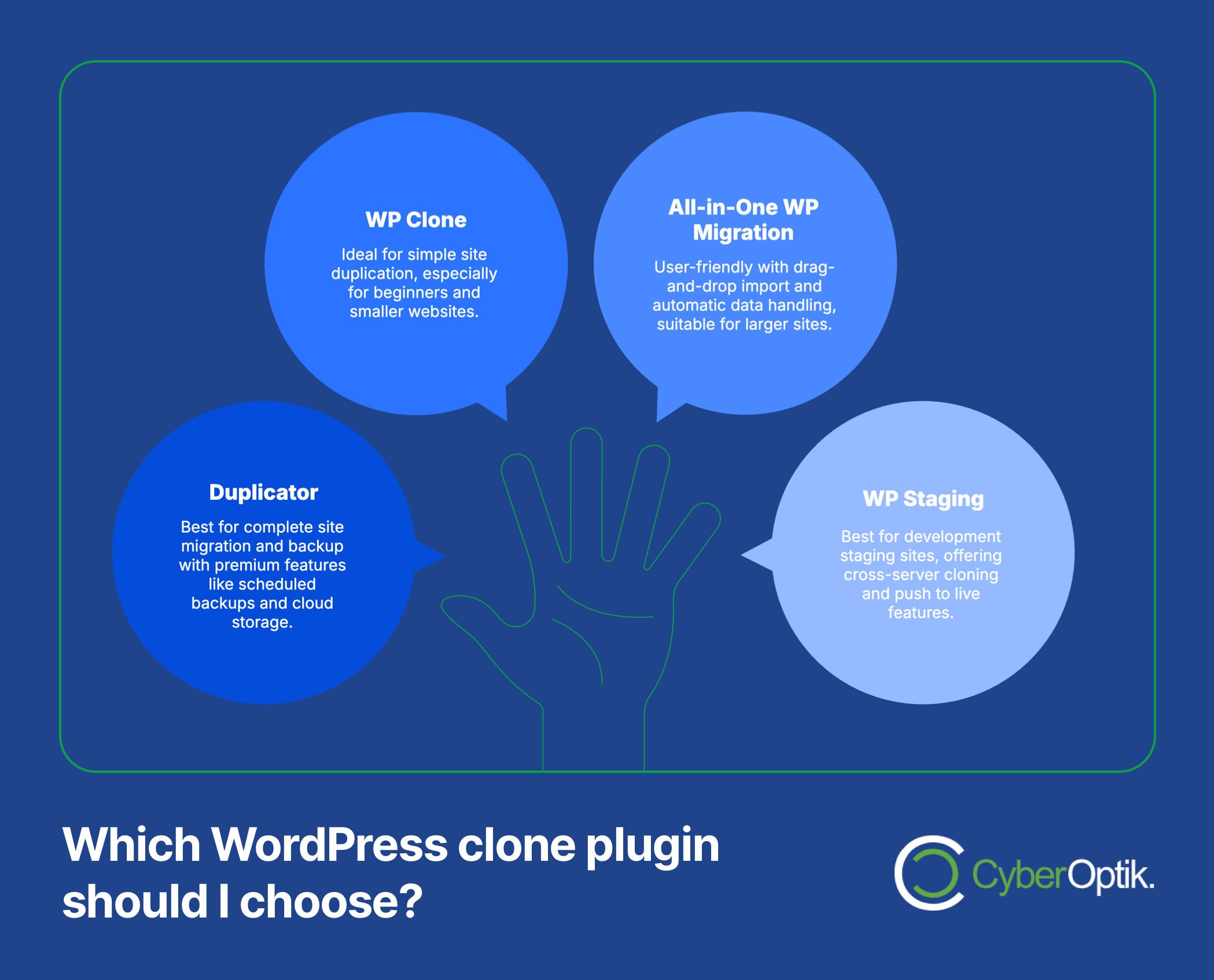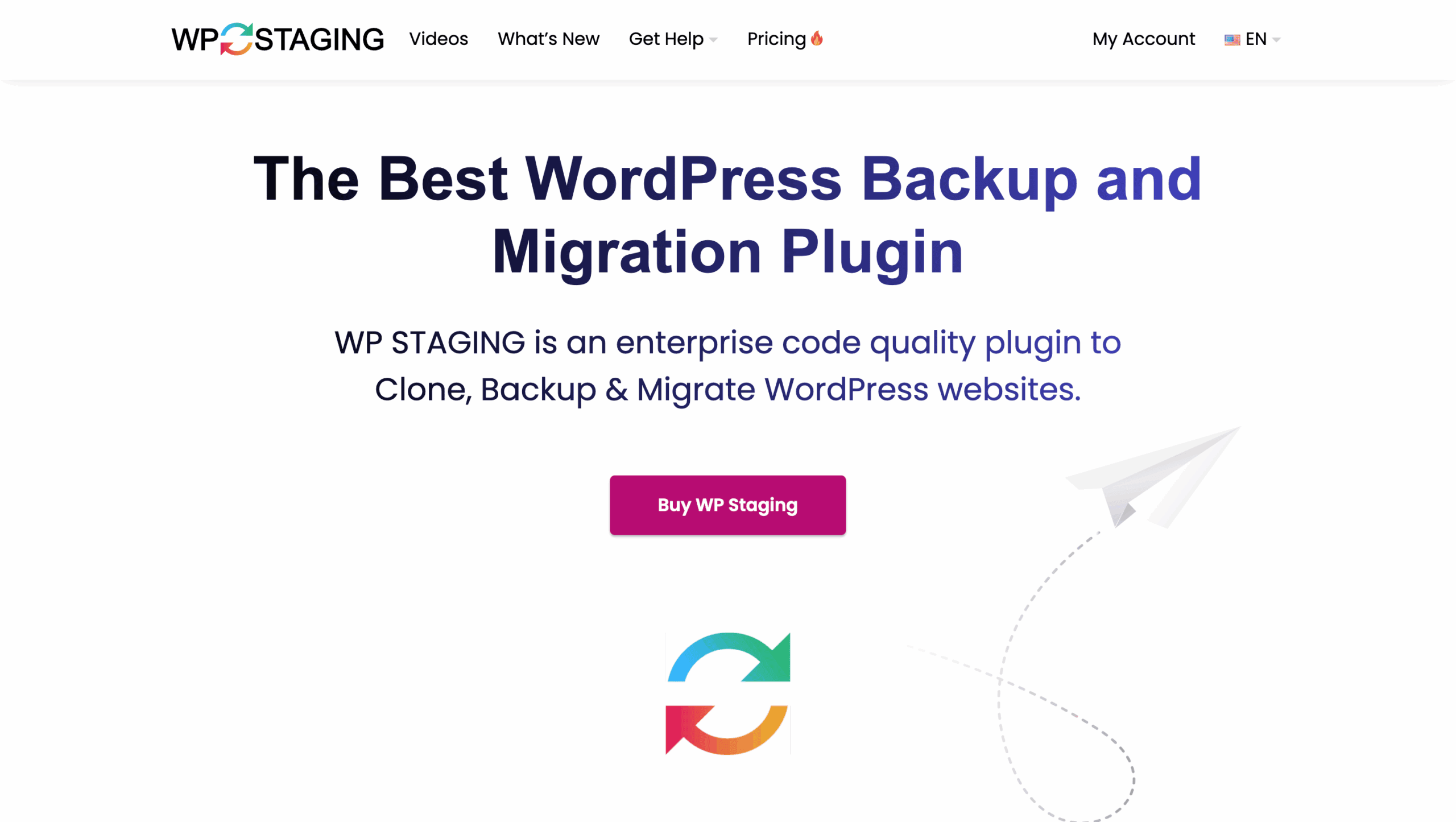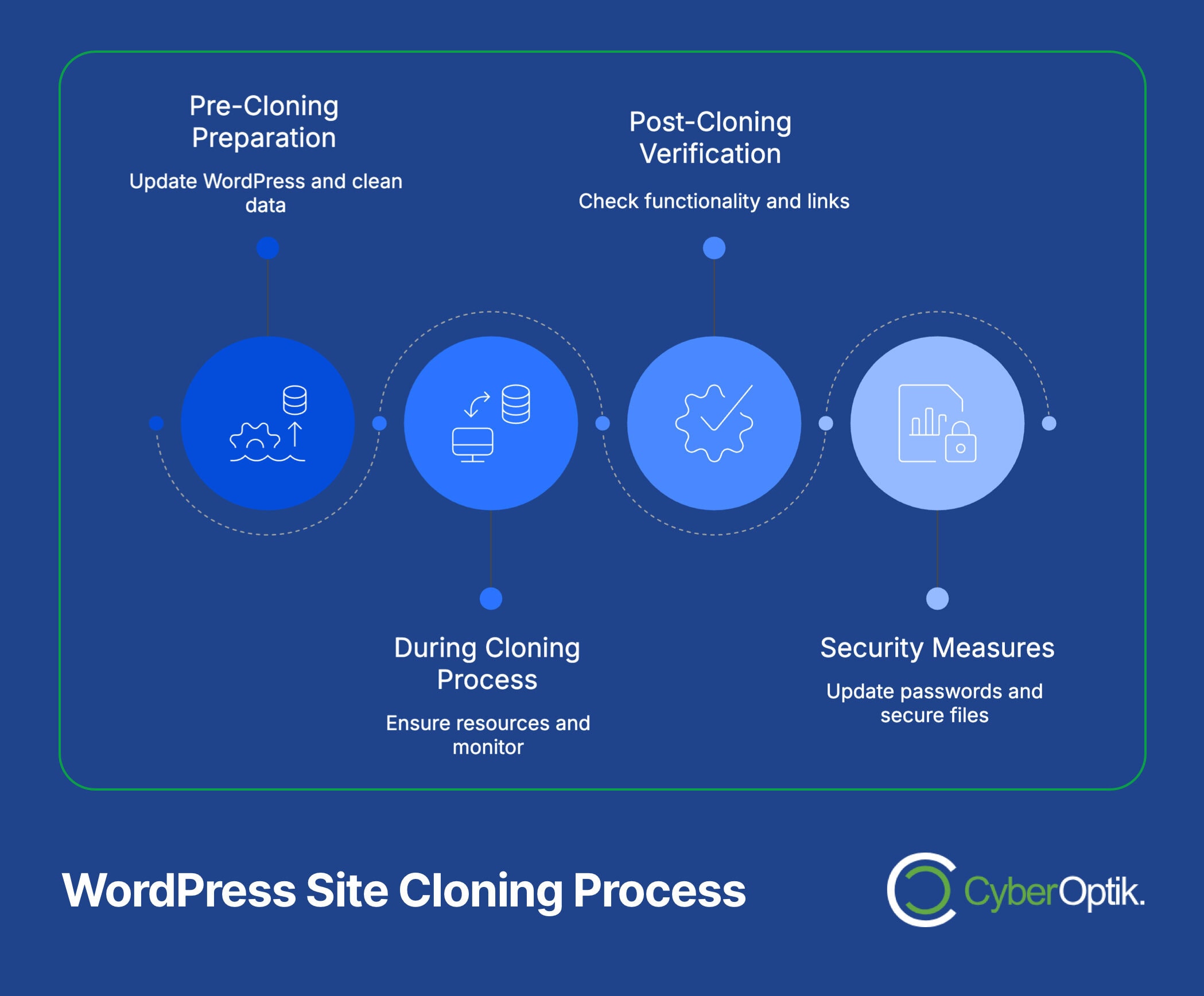Creating duplicate WordPress sites efficiently can transform your development process. As a web design agency working with WordPress daily, we know how valuable time becomes when managing multiple projects. WordPress clone plugins offer a simple solution to what was once a complex, time-consuming task.
Whether you need to create a testing environment, migrate a site to a new host, or build similar websites for multiple clients, the right cloning plugin makes all the difference. These specialized tools handle everything from database transfers to file copying with minimal hassle.
In this guide, we’ll explore the best WordPress clone plugins available today. We’ll cover their key features, benefits, and how to select the right one for your specific needs. Let’s get started with the basics.
Understanding WordPress Clone Plugins
WordPress clone plugins are specialized tools that create exact copies of WordPress websites. They capture everything from files and database content to themes, plugins, and custom settings. This comprehensive approach ensures your duplicated site functions exactly like the original.
Unlike manual backup and restore methods, clone plugins automate the entire process. They handle complex tasks like serialized data migration and database credential updates. This automation significantly reduces the technical expertise needed for successful site duplication.
Most clone plugins work through a straightforward process. First, they create a package or snapshot of your existing site. Then, they provide tools to deploy this package to a new location. This location could be a subdomain, a local environment, or an entirely different server.
The Technical Side of WordPress Cloning
When a WordPress site is cloned, several technical operations happen behind the scenes. The plugin must properly export the database, compress all files, and handle complex data relationships. Special attention goes to the wp-config.php file, which contains crucial database connection details.
Modern cloning tools also deal with serialized data correctly. This special data format in WordPress databases often causes issues during traditional migration methods. Good cloning plugins handle these formats properly, preventing broken functionality on the new site.
Another key aspect is path management. When moving a site to a new location, file paths need updating throughout the database. Clone plugins automatically adjust these paths during the migration process, saving hours of manual corrections.
Benefits of Using WordPress Clone Plugins

WordPress clone plugins offer numerous advantages for developers, site owners, and agencies. Understanding these benefits helps explain why these tools have become essential for professional WordPress management. Here are the key advantages of using quality cloning solutions:
- Time efficiency – Reduce hours of manual work to minutes of automated processes
- Error reduction – Minimize human mistakes that commonly occur during manual migrations
- Consistent testing environments – Create identical staging sites for safe testing
- Simplified backup solution – Generate complete, deployable backups of entire sites
- Client site replication – Quickly create similar sites with shared foundational elements
For web development agencies like ours, these benefits translate directly to business value. We can deliver projects faster, reduce technical complications, and maintain consistent quality across multiple sites. This efficiency allows us to focus more on customization and client-specific needs.
The benefits extend beyond time savings. Using a reliable cloning plugin also reduces the stress associated with major site changes. With a proper clone in place, you can experiment freely knowing you can always revert if needed. This safety net encourages innovation and thorough testing.
Development Workflow Improvements
A major advantage of clone plugins is the improved development workflow they enable. Developers can build locally, test thoroughly, then deploy to live environments with minimal friction. This local-to-live workflow reduces risks and improves site quality.
When multiple developers work on the same project, cloning provides consistent environments for everyone. Each team member can work with an identical copy of the site, eliminating the “it works on my machine” problem. This consistency leads to better collaboration and fewer integration issues.
Clone plugins also facilitate the creation of template sites. Agencies can build standardized starter sites with common plugins, themes, and configurations. These templates can then be quickly duplicated and customized for new clients, saving significant setup time.
| Development Need | Solution Without Clone Plugins | Solution With Clone Plugins | Time Savings |
|---|---|---|---|
| Creating a staging site | Manual backup, files transfer, database import, configuration updates | One-click clone operation with automated adjustments | 1-3 hours |
| Site migration to new host | Export database, download files, upload to new host, reconfigure | Create package, upload, deploy with automatic adjustments | 2-4 hours |
| Creating similar client sites | Build each site from scratch with similar elements | Clone template site and customize for new client | 4-8 hours per site |
| Developer onboarding | Document setup process, troubleshoot individual environment issues | Provide clone package for identical local setup | 2-6 hours per developer |
As this table illustrates, the time savings from using clone plugins can be substantial across various development scenarios. For busy agencies and developers, these hours directly impact project timelines and profitability.

Top WordPress Clone Plugins for Site Duplication
Several excellent WordPress clone plugins are available today. Each offers unique features and approaches to site duplication. Here’s a comprehensive look at the top options to consider for your cloning needs:
Duplicator

Duplicator stands as one of the most popular and robust WordPress cloning solutions available. This powerful tool offers both free and premium versions to suit different needs and budgets. The plugin excels at creating complete website packages that can be deployed to new locations.
The free version of Duplicator provides core functionality for basic site cloning and migration. It handles standard-sized websites effectively and includes features for manual database table selection and basic filtering. Many users find this version sufficient for occasional cloning needs.
Duplicator Pro expands capabilities significantly with features like scheduled backups, cloud storage integration, and multisite support. According to the official website, Duplicator Pro allows users to “pause and resume the backup process when creating packages,” making it ideal for larger sites.
One notable security concern arose in 2020 when security researchers discovered a vulnerability in the Duplicator plugin. This security issue allowed attackers to download arbitrary files from affected websites without authentication. The vulnerability was actively exploited in the wild, affecting many WordPress sites.
WP Clone

WP Clone offers a streamlined approach to site duplication with a focus on simplicity. This plugin creates a backup of your site that can be restored to a new location, effectively cloning your WordPress installation. It’s particularly suited for smaller websites and beginners.
The plugin uses a direct site-to-site copying method that eliminates the need for manual file downloads and uploads. This approach makes it very beginner-friendly but can be less reliable for complex or large sites. Despite its simplicity, it handles most basic cloning tasks effectively.
WP Clone includes database optimization during the cloning process, which can result in improved performance on the cloned site. This feature sets it apart from some other free options that simply copy data without any optimization steps.
All-in-One WP Migration

All-in-One WP Migration takes a comprehensive approach to site duplication and migration. The plugin focuses on simplicity without sacrificing power, making it accessible to users of all technical levels. Its drag-and-drop import feature is particularly user-friendly.
This plugin excels at handling site migrations between different domains and server environments. It automatically handles serialized data and performs find-and-replace operations throughout the database. These features help prevent common migration issues.
The free version has file size limitations, while premium extensions remove these restrictions and add features like multisite support and cloud storage integration. For agencies managing multiple sites, these premium features often justify the investment.
WP Staging

WP Staging specializes in creating testing environments for WordPress sites. Rather than focusing primarily on migration, it creates staging copies of live sites for safe development and testing. This specialized focus makes it ideal for ongoing development work.
The plugin creates a subdirectory installation of your site on the same server, which makes it very fast and reliable. This approach also means no downloading or uploading of files is required. For developers working on site updates, this efficiency is invaluable.
While the free version provides basic staging functionality, the pro version adds push changes to live site, cloning between different hosts, and more advanced features. For development teams, these pro features significantly enhance workflow efficiency.
| Plugin Name | Best For | Free Version Capabilities | Premium Features | Price (Premium) |
|---|---|---|---|---|
| Duplicator | Complete site migration, backup | Basic site cloning, manual filtering | Scheduled backups, cloud storage, multisite support | $69-$349/year |
| WP Clone | Simple site duplication | Basic cloning, DB optimization | N/A (No premium version) | Free |
| All-in-One WP Migration | User-friendly migrations | Basic migration with size limits | Unlimited size, cloud storage, multisite | $69-$299/year |
| WP Staging | Development staging sites | Basic staging on same server | Push to live, cross-server cloning | $89-$289/year |
This comparison helps illustrate the strengths of each plugin and which scenarios they best serve. Your specific needs will determine which option provides the most value for your workflow.
How to Choose the Right WordPress Clone Plugin
Selecting the ideal WordPress clone plugin depends on several factors specific to your situation. Consider these key elements when making your decision:
Site Size and Complexity
The size and complexity of your WordPress site significantly impact which cloning tool will work best. Larger sites with extensive databases require plugins with robust handling of large data sets. Simple blogs might work well with basic solutions, but complex sites need more powerful tools.
Sites with many custom post types, advanced custom fields, or extensive WooCommerce data need specialized handling. Premium versions of plugins like Duplicator or All-in-One WP Migration generally offer better support for complex data structures. Free versions often struggle with very large or complex sites.
Also consider your site’s hosting environment. Some budget hosting plans restrict resource usage or have low PHP limits. These restrictions can interfere with cloning operations, particularly for larger sites. In these cases, plugins with incremental processing capabilities are necessary.
Technical Expertise Available
Your team’s technical skills should influence your plugin choice. Some tools provide automation and simplicity ideal for beginners, while others offer advanced customization options that benefit experienced developers. Be realistic about your technical capabilities when choosing.
For non-technical users, look for plugins with wizard-based interfaces and simplified workflows. WP Clone and the basic version of All-in-One WP Migration excel in user-friendliness. These tools prioritize simplicity over advanced customization options.
If you have development expertise, consider plugins that offer more control. Duplicator Pro provides extensive customization options for how files and databases are packaged and deployed. This flexibility is valuable for complex migration scenarios.
Frequency of Use
How often you’ll use the cloning functionality affects which plugin provides the best value. Occasional use cases might be well-served by free options, while frequent cloning justifies investment in premium tools with automation features.
For agencies that regularly create similar sites for clients, premium tools with templating capabilities offer significant time savings. The ability to save package profiles and customize deployment options streamlines repetitive work.
If you primarily need staging sites for development, specialized tools like WP Staging may be more efficient than full cloning plugins. These tools optimize the specific workflow of creating test environments and pushing changes.
Budget Considerations
Budget constraints naturally influence plugin selection. Fortunately, options exist at various price points, from free tools to premium solutions with advanced features. Consider the value of time saved against the cost of the plugin.
Many developers find that premium cloning tools pay for themselves quickly through time savings. When evaluating costs, calculate the time value of manual migration versus automated solutions. A premium plugin that saves hours per project often justifies its cost after just a few uses.
Some plugins offer lifetime deals or agency pricing that can provide better value for teams managing multiple sites. These licensing options typically reduce the per-site cost significantly compared to single-site licenses.
| Selection Factor | Questions to Ask | Recommended Plugin Types |
|---|---|---|
| Site Size | How large is your database? How many files? Any large media libraries? | Large sites: Premium tools with chunking capabilities (Duplicator Pro, WP Staging Pro) |
| Technical Skill | Are you comfortable with databases? Can you troubleshoot PHP issues? | Low skill: WP Clone, All-in-One WP Migration High skill: Duplicator Pro with custom options |
| Use Frequency | How often will you clone sites? Is this for multiple clients? | Occasional: Free tools Regular: Premium tools with automation |
| Security Needs | How sensitive is your data? Do you need encryption? | High security: Premium tools with encryption and secure storage options |
This decision matrix helps organize your thinking around the most important factors. Prioritize these elements based on your specific situation to find your ideal plugin match.
Best Practices for WordPress Site Cloning
Regardless of which plugin you choose, following these best practices will help ensure successful WordPress site cloning. These guidelines minimize risks and optimize results for any cloning operation.

Before Cloning
Proper preparation makes a significant difference in cloning success. Start by cleaning up your source site to ensure you’re not duplicating unnecessary data. Remove unused plugins, themes, and media files that won’t be needed on the new site.
Update everything before cloning. This includes WordPress core, themes, and plugins. Working with the latest versions reduces compatibility issues and ensures security patches are included in your cloned site. Outdated components can cause unexpected problems.
Consider whether your WordPress plugins will all be needed on the new site. Having too many plugins can affect performance and increase security risks. Research indicates that the average WordPress site has 20-30 plugins installed, but experts suggest that having more than 15-20 active plugins may impact site performance.
During the Cloning Process
When initiating the clone operation, ensure your server has sufficient resources available. Cloning is resource-intensive, particularly for larger sites. If possible, schedule cloning during low-traffic periods to minimize impact on server performance.
For large sites, consider using incremental cloning features if available in your chosen plugin. These features break the process into smaller chunks, reducing the risk of timeouts and memory issues. This approach is particularly important on shared hosting environments.
Document the cloning process, including any custom settings or issues encountered. This documentation proves invaluable if you need to repeat the process or troubleshoot problems later. Include details about server environments, plugin versions, and configuration choices.
After Successful Cloning
After creating your clone, always verify its functionality thoroughly. Check critical pages, forms, and features to ensure everything works as expected. Pay special attention to third-party integrations and complex functionality that might be affected by the move.
Update internal links and references on the new site. While good cloning plugins handle most URL changes automatically, custom hardcoded links may need manual updates. Tools like “Better Search Replace” can help find and replace domain references throughout the database.
If the cloned site will be used for live traffic, implement proper security measures before making it public. Update passwords, API keys, and access credentials. Consider whether you need to transfer or reconfigure security plugins and settings.
For staging or development sites, take steps to prevent search engine indexing and public access. This usually involves enabling a “discourage search engines” option and possibly adding password protection. These precautions prevent confusion between your live and development environments.
Security Considerations
Security vulnerabilities in WordPress plugins can expose your site to attacks. In early 2020, security researchers discovered that active attacks were targeting Duplicator, a popular WordPress cloning plugin. Attackers exploited a vulnerability that allowed unauthorized users to download arbitrary files, potentially including sensitive configuration files.
This incident highlights the importance of keeping all plugins updated, including cloning tools. Always use the latest version available, as developers regularly release patches for security issues. Check for updates before starting any cloning process.
Be cautious about where cloned data is stored. If creating backups as part of the cloning process, ensure they’re secured properly. Backup files contain sensitive information including database credentials and user data. Never leave these files publicly accessible on servers or unsecured cloud storage.
| Cloning Stage | Best Practice | Common Mistake to Avoid |
|---|---|---|
| Pre-Cloning | Update all components, clean unnecessary data | Cloning without checking plugin compatibility |
| During Cloning | Ensure sufficient server resources | Attempting to clone during high-traffic periods |
| Post-Cloning | Verify functionality, update security credentials | Leaving development sites publicly accessible |
| Security | Use latest plugin versions, secure backup files | Neglecting to update passwords on the new site |
Following these best practices minimizes the risks associated with site cloning and helps ensure a smooth transition to your new environment. Each step contributes to a more reliable and secure outcome.
Common Issues and Troubleshooting
Even with the best plugins and careful preparation, issues can arise during the cloning process. Understanding common problems and their solutions helps you resolve them quickly. Here are the most frequent challenges and how to address them:
Timeouts During Cloning
Server timeouts are among the most common issues when cloning larger sites. This happens when the process exceeds time limits set by your hosting provider. The cloning operation stops midway, resulting in incomplete transfers.
To resolve timeout issues, try these approaches:
- Use a plugin with chunking capabilities that break the process into smaller steps
- Temporarily increase PHP timeout limits if your hosting allows this
- Reduce package size by excluding unnecessary files (like cache folders)
- Perform the clone during low-traffic periods when more server resources are available
Some premium cloning tools include built-in mechanisms to handle timeouts by automatically resuming operations. This feature alone often justifies the cost for larger sites or restrictive hosting environments.
Database Connection Errors
When deploying a clone to a new location, database connection errors frequently occur. These usually happen because the wp-config.php file contains database credentials that don’t match the new environment. Most quality cloning plugins handle this automatically, but issues can still arise.
If you encounter database connection problems:
First, verify the database credentials in the new wp-config.php file match your actual database settings. Check the database name, username, password, and host values. Even one incorrect character will prevent connection.
For manual deployments, ensure you’ve created a new database and user on the destination server before attempting to import. The user must have full privileges on the database. Some cloning plugins can create these automatically, but others require manual setup.
If using cPanel, check whether your database name requires a prefix (often the cPanel username followed by an underscore). This is a common source of confusion when moving between different hosting environments.
Missing Files or Content
Sometimes the cloned site appears to work but has missing images, pages, or functionality. This partial transfer can happen for several reasons, including improper filter settings or server restrictions.
To address missing content issues:
Review the cloning plugin’s logs or reports for any warnings about skipped files. Many plugins provide detailed information about what was included or excluded from the package. This can help identify what’s missing and why.
Check filter settings in your cloning tool. You might have accidentally excluded important directories or file types. Common exclusions that cause problems include uploads folders, custom theme files, or specific plugin directories.
Verify file permissions on the destination server. Incorrect permissions can prevent access to certain files or folders, making them appear missing. Standard permissions are 755 for directories and 644 for files in most WordPress installations.
Styling and Layout Issues
After cloning, you might notice design problems like broken layouts, missing styles, or improperly loaded images. These visual issues often relate to path problems or caching.
To fix styling and layout problems:
Clear all caches thoroughly. This includes browser cache, plugin caches, and any server-level caching. Old cached versions of pages can display outdated styling that doesn’t reflect your current site.
Check for hardcoded paths in theme files. Some themes use absolute URLs instead of relative paths for resources like images and stylesheets. These need updating to match the new domain or path.
Inspect the site’s source code for references to the old domain. Sometimes these remain in inline styles or JavaScript even after database search-and-replace operations. A thorough database search for the old domain can help identify remaining references.
| Issue | Common Causes | Solution |
|---|---|---|
| Timeouts | Large site size, limited server resources, PHP time limits | Use chunking, increase limits if possible, exclude unnecessary files |
| Database Errors | Incorrect credentials, missing database, insufficient privileges | Verify wp-config.php settings, create database beforehand, check user permissions |
| Missing Content | Filter settings, partial transfers, permission issues | Review logs, check filters, verify file permissions |
| Styling Problems | Hardcoded paths, caching, incomplete search-replace | Clear all caches, update absolute paths, check source code for old domain references |
By understanding these common issues and their solutions, you can troubleshoot most cloning problems efficiently. Remember that premium support from plugin developers can be invaluable when facing complex migration challenges.
Conclusion
WordPress clone plugins represent essential tools for developers, agencies, and site owners looking to streamline their workflow. The right cloning solution can save countless hours, reduce errors, and enable more efficient site management practices. From simple site duplication to complex migrations, these tools transform what was once a technical challenge into a straightforward process.
When selecting a WordPress clone plugin, consider your specific needs, technical capabilities, and budget. Free options work well for basic scenarios, while premium tools offer valuable features for complex sites and professional workflows. Regularly updated plugins with good security records should always be prioritized to protect your valuable site data.
Following best practices before, during, and after the cloning process helps ensure successful outcomes. Proper preparation, resource management, and post-cloning verification are key steps that shouldn’t be skipped. When issues do arise, a systematic troubleshooting approach addressing common problems like timeouts, database errors, and content issues will help resolve them quickly.
For web agencies like ours, mastering WordPress cloning tools has become fundamental to providing efficient client services. These plugins enable us to create consistent development environments, deliver projects faster, and maintain high-quality standards across multiple sites. If you’re looking to improve your WordPress workflow, investing time in learning and implementing these powerful tools will yield significant returns.
Ready to enhance your WordPress development process? Start by evaluating the clone plugins discussed in this guide based on your specific needs, and take your first step toward a more efficient workflow today. Your future self will thank you for the hours saved and headaches avoided.




